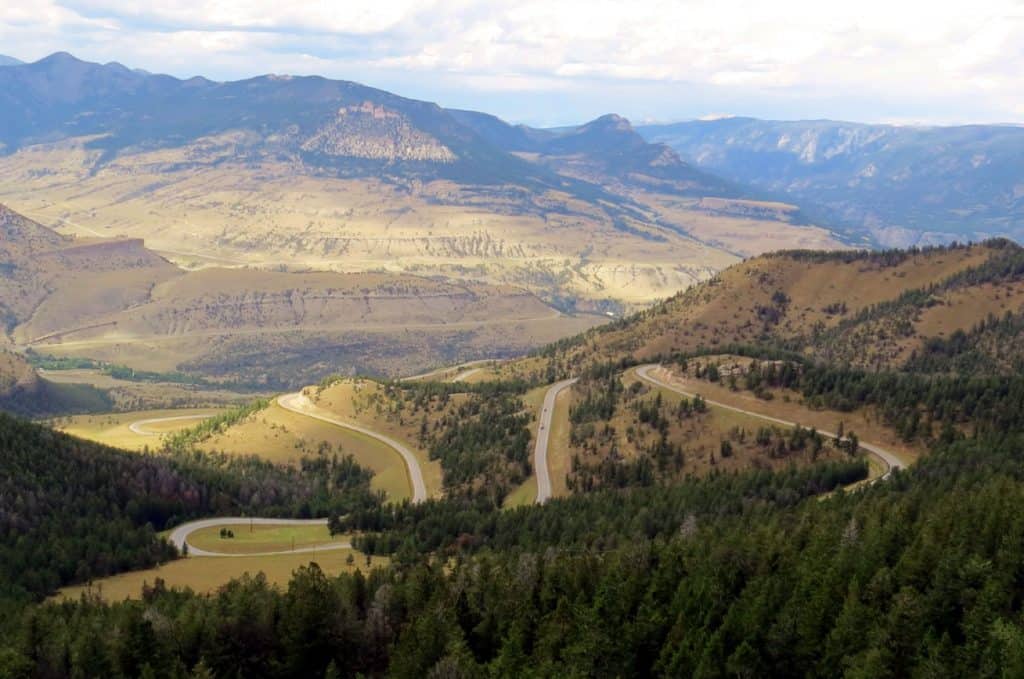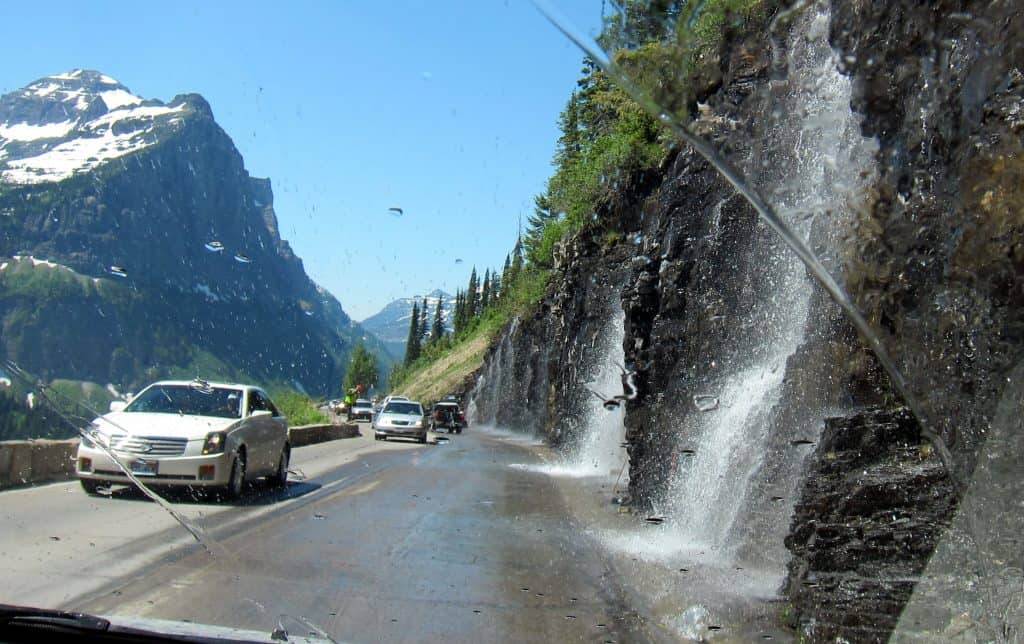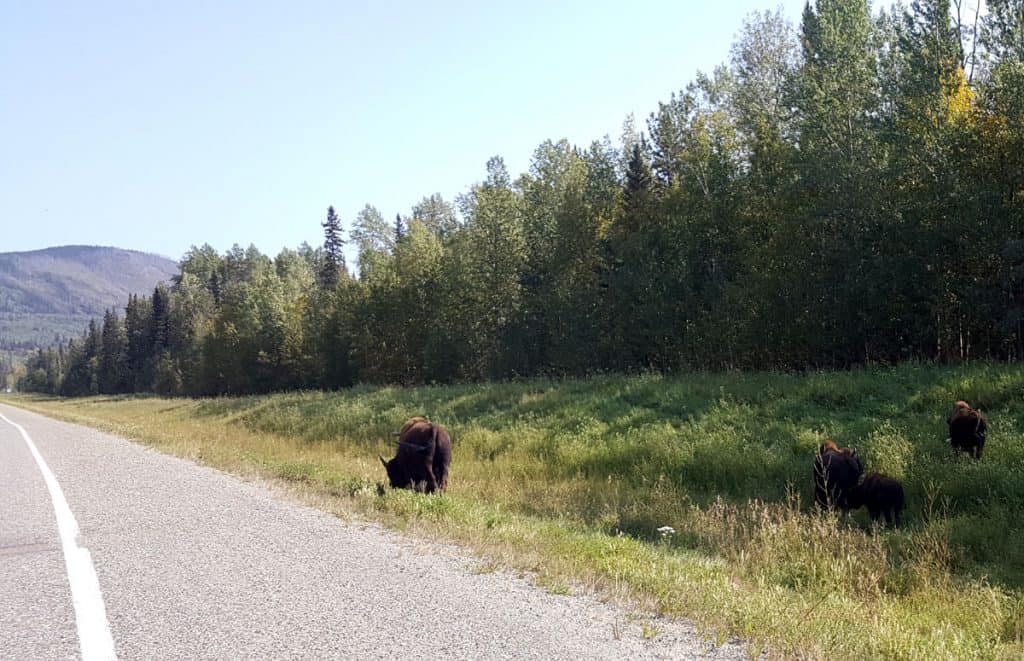Are you thinking about buying or renting an RV for your next vacation but worried about driving on steep, winding mountain roads? Not only do we have first-hand experience driving across some of the most dramatic mountain passes in the US, but we also did the research needed for you so that your next RV vacation will be enjoyable and relatively worry-free.
 The basic guidelines for safely driving an RV on mountain roads are:
The basic guidelines for safely driving an RV on mountain roads are:
- Use lower gears when climbing uphill
- Stick to first gear to brake when going downhill
- Make sure you're not towing or hauling too much weight
- Keep an eye on engine temperature
- Watch the curves and slow down
- Pull over to let traffic pass you
- Plan ahead
- Aim for good driving conditions
Keep reading as we share from our own experience and research to show you how to safely manage these gorgeous mountain passes.
What are mountain roads?
Out in the west, they call them mountain passes. In the east coast, they're known as notches. No matter how you call them, these roads offer some of the best views in the USA and are well-worth traversing. Even with an RV.
A mountain pass is a road that takes you across a mountain range. It's not easy to pave a road in mountainous terrain, so most roads you'll travel across will be across relatively flat land. However, sometimes you just need to get across a mountain range - and that's when you have to take a mountain pass.
The main mountain ranges in the US (from east to west) are -
- The Appalachians
- The Rockies
- The Sierra Nevada and Cascades (basically the same range)
If your RV road trip takes you from east to west, you'll probably have to traverse one or more of these massive ranges. The only way around them is by taking a very southern route. That southern route is beautiful in its own right but don't choose that road just because you're afraid of the mountains. You'll be missing out on beautiful areas if you do.
Instead, let's talk about how to safely cross those mountains in an RV (or any large vehicle).
What makes driving a mountain road so hard?
Let's face it, driving can be difficult in general, but it doesn't have to be. Be sure to stop and check out our post that talks in depth about the various driving challenges and how to overcome them.
So what makes driving on mountain roads so difficult?
Two things: grades and curves. And when you're driving an RV, both are made worse due to the sheer mass of your vehicle. That's physics in action for you.
Gravity is the force at play in an incline, while the centrifugal force is the one pulling you sideways when you're taking a turn. Both are much more powerful, the heavier and larger your vehicle is.
A mountain pass has to get vehicles climbing up and rising in altitude, and then down again on the other side of the range. The overall altitude gain depends on your starting point and the high point of the road. When driving across the continental divide in the Colorado Rocky Mountains, you'll be going above 14,000 ft in some cases. That's quite a climb!

Road grades
Not school grades. Road grade - as in the measure of the steepness of a road. A zero grade means there is no slope or steepness while the upper limit on U.S. Federal highways of 6%, or 7%.
Keep in mind this only applies to Federal highways and there will be more-steeply-graded local roads in mountainous areas. For a first-time mountain road driver, however, sticking to the interstate highway system might make planning a lot easier. Your level of adventure is your choice and of course your responsibility.
Curves and switchbacks
To maintain a sensible road grade, these roads utilize curves and switchbacks. That's why mountain roads are winding - by definition. Sometimes extremely so.

Driving a motorhome, you're steering a heavy and tall vehicle. If you're towing a 5th wheel or a travel trailer, you're steering an even longer rig in total. Taking on a sharp switchback when you're that long is not easy.
Now that we understand what makes these mountain roads so challenging for RVs, let's talk about how you meet these challenges, safely.
Narrow Roads
More often than not, a mountain pass will be narrow. Not always. There are highways that cut through mountain ranges too. But sometimes, it could be as narrow as the Going to the Sun Road, in Glacier National Park, or the Million Dollar Highway between Durango and Ouray in Colorado:

Inclines: Taking an RV up a mountain road
There are two parts to a mountain pass. You go up one way, reach the top and then begin your descent on the other end of the range.
As you're climbing up, gravity will take care of slowing you down. Depending on your weight and road conditions, a large RV may actually find it hard to make the climb.
The key to traversing a steep incline is to use the lower gears. Using the lower gear on your motorhome or truck helps you get more torque and that's the force that can help pull all of that weight uphill.
And don't go beyond your towing or hauling max point. It may work when on a level road but not on a steep incline.
Taking an RV down a mountain road
Once you've passed the top of the road, you'll start going down the other end of the mountain. This time gravity is pulling you forward. Much easier, right?
Not really.
As you're driving downhill, gravity pulls your vehicle down. You accelerate more and more. There's a limit to how fast you want to be driving an RV - especially towing - even on a level road. Coming down a mountain road, you'll have to go even more slowly because of those curves and switchbacks. They're actually there to make you do just that - go more slowly.
The problem is - how to slow down safely?
Even if you have no experience with driving an RV, you probably know that when going downhill, you should slow a vehicle down using the engine - not the brakes.
The key here - once again - is to use a lower gear. You're now using all of that torque to slow down the vehicle.
Use the first gear only
Yes, it's super slow - but it's the only way to really help you keep your foot off the brakes. Completely off - if you can help it.
If you're touching the brake pedal "a little bit", every now and then. You may be thinking you're not really over-using them, right? After all, you use them much more often at home, when you're just driving through town and stopping at red lights.
You're wrong.
Here's the thing.
The larger the vehicle you're driving, the harder your brakes need to work in order to slow it down. You're putting a whole lot more pressure on your brakes whenever you're using them on mountain roads.
And mountain roads tend to be long. You could easily be driving down one for half an hour, without even noticing it.
This actually happened to us once. Driving down Mt. Washington, we switched from the first to the second gear throughout the way. Driving in first gear the entire time was too frustrating. Halfway down, we were pulled over by a ranger to check the temperature of the brakes. There was no smell and no other indication of a problem but sure enough, the brakes had heated up. We had to stay and wait there for 15 minutes to allow the brakes time to cool off.
Driving down mountain roads need to be done slowly using the first gear only.
Exhaust braking with a diesel engine
If you have a diesel engine, there is something called exhaust braking which will help you save your brakes for when you really need them.
Check to see if your diesel pusher has an exhaust brake and if so, what type. There are various kinds and they operate in slightly different ways. Some of them are too noisy to be used inside towns but may be ok to use driving in the mountains.
Watch your weight!
If you're towing or hauling too much weight, this is where things can get problematic.
Combining towing above your rating, a slippery wet road, and a steep incline could actually mean you won't be able to move forward on the road. And yes, that is super dangerous, as you could find yourself coming to a halt and even slowly rolling backward!
When going down, braking using the engine may not be enough either. You'll start hitting the brakes, and could quickly lose them - and control over your vehicle!
Never drive on a mountain road if you're hauling or towing above your ratings.
Engine Overheating (Old Vehicle Issues)
When climbing mountain roads your RV’s engine will experience more strain and could heat up. The same is actually true when going down - as you know by now that you need to slow the vehicle down using that same engine.
It’s important to monitor the engine temperature via the temperature gauge on the instrument panel, or if there isn’t one, to keep an eye out for the engine overheating light.
As is recommended before any long trip, be sure to have your RV serviced and inspected. An early oil change can help as well if it’s been some time. Be sure you know what the engine overheating light looks like and where it’s placed on your RV’s instrument panel.
You may try to practice pulling the RV over to the side of the road once before setting out if unfamiliar with the vehicle. Plan for this extra time required and if needed, put your hazard lights on to alert other drivers to your slower pace.
If you're driving a new RV or towing one with a new pickup truck, you should be ok. Newer engines rarely overheat. However, older models may have issues, so keep this in mind.
Slow down for the curves
Driving through the mountains, you'll be going on roads that are anything but straight and level.

Switchbacks will slow an RV almost to a halt. In fact, we've been through switchbacks that will slow a large vehicle to a halt. Period. Some were bad enough to require maneuvering back and forth to get across.
Fortunately, there are not many of those around. Most switchbacks aren't that bad.
Then there are curves. When a road just hugs the contour of a local river or canyon. Sometimes, the road is level - a grade of zero - but it's just not straight.
When you encounter a curve, watch for the signs indicating the maximum speed. They will usually show one speed for smaller vehicles and one for semis. Driving an RV, you're one of the "big boys" so follow the speed limit for trucks.

In our experience, the speed limit on a curve usually gives a very good indication of how bad the turn will be. If you're new to driving the RV, you can go slower. Just don't go over the speed limit.
Allow faster traffic to pass you safely
You will be going more slowly than a sedan. No two ways about it.
And faster cars behind you will have a very hard time taking you over safely. Visibility is usually limited on winding mountain roads and inclines make it harder for those cars to take get past you fast enough.
If they're unsafe - you're unsafe. Not only will they tailgate you but you'll be stuck in the middle as they try to take you over really fast and in a very unsafe way. So it's up to you to allow them to take you over safely. Here's how to do that.
Most mountain roads will either have special extra lanes for bypassing every 4-5 miles, or they'll have special pull outs for large rigs to stand on as the smaller cars go by.
On bypassing lanes, make sure you stick to the right. Don't try to overtake other large rigs, unless you're 100% sure you can do that safely and relatively fast. If others are waiting behind you to take you over, let them.
No bypassing lanes? Then watch out for pullouts. As you see one coming, use your indicator to show the driver behind you that you're about to slow down and pull over. Pull over, usually to a full stop. Wait until all of the faster cars go by and then get back on the road.
When to do that? Whenever you notice someone tailgating you or if there's a "comet tail" of more than a couple of cars behind you. Even if you're traveling to the full extent of the speed limit, they can probably go faster than you - so let them.

Driving an RV through the Mountains? Plan ahead
Safe driving through mountain roads starts with knowing the route you’ll be taking before you set out on your journey. There are a number of resources available for that:
Google Maps
Google maps allows you to investigate the road in great detail. You can literally get down to street-view level and take a look at the curves and inclines. We find this to be an invaluable resource in planning any drive and road trip.
State department of transportation websites
These sites often list weather conditions as well as road conditions. It's good to check those nearer to your time of approach.
Books and websites
Additionally, there are book references available online, such as the ‘Mountain Directory West for Truckers, RV and Motorhome Drivers’ and yes there’s an app for that. There are also general guides to the roads, which include non-mountain roads, such as ‘The Next Exit’.
Guides like these will help you plan ahead in terms of what resources are available to you should you encounter trouble such as an overheating engine, overheated brakes or simply an overfilled bladder.
Knowing where the tunnels are and where you are able to safely pull your RV over to the side of the road can help you gauge when to stop and rest the brakes and engine before an upcoming stretch of road as well as know where you will be able to get lunch and use restrooms.
Aim for good driving conditions
Driving in poor weather is never much fun. When in the mountains, it can be downright dangerous.
During wintertime, mountain roads can easily ice over or get covered in snow. That means you get less traction on the road, so you need to drive even more slowly.
At night time, seeing those curves and inclines becomes a challenge. What's more, the road is often darker because of mountains on either side blocking out what little light you could otherwise be getting from the stars and the moon.
You also get fewer hours with full light. Sunset may be at 7 PM but you'll find that a mountain road becomes dark long before that. Often, it's not just the mountains that block the light, but also the woodland around the road itself.
And then there are the animals.
Watch out for animals on the road or next to the road. They can be very unpredictable. We have come very close to hitting a deer driving on mountain roads. It's also common to see elk, moose, bear, and bison alongside mountain roads in the US and Canada.

If possible, plan to get your RV on the road during the right season and on the right hours of the day. Summertime between 8 AM and 6 PM is usually safest in most mountain areas in the US and Canada. Otherwise, watch the weather and look for sunrise and sunset times, then allow a buffer of two hours after sunrise and before sunset for safe mountain travel.
You Can Do This
Don't give up on a road trip just because it's in the mountains. Mountain areas are absolutely gorgeous. They're perfect destinations for RV's - you just need to know how to approach them and traverse them safely. Hopefully, this post helped!
And if you have some experience and care to share more tips - please do!

Such a helpful article!!! Thank you!